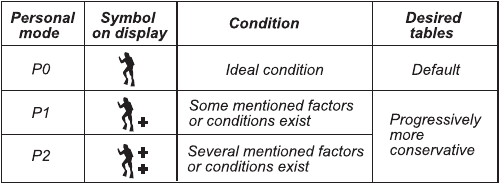
41
• cold exposure - water temperature less than 20 °C [68 °F]
• the diver is below average physical fi tness level
• diver fatigue
• diver dehydration
• previous history of DCI
• stress
• obesity
The Personal Adjustment Mode is indicated by a diver symbol and plus
signs (P0 = a diver, P1 = diver +, or P2 = diver ++). Section 4.3.1.1. ”Al-
titude Adjustment and Personal Adjustment Setting” describes how the
Personal Mode is adjusted.
This feature should be used to adjust the computer to be more conserva-
tive, according to personal preference, by entering the suitable Personal
Adjustment Mode with the help of Table 3.5. In ideal conditions, retain
the default setting, P0. If conditions are more diffi cult or other mentioned
factors which tend to increase the possibility of DCI exist, select P1 or
even the most conservative P2. As a result the dive computer adjusts
its mathematical model according to the entered Personal Adjustment
Mode, giving shorter no-decompression times (see section 6.1. ”Operat-
ing Principles”, Table 6.1 and 6.2).
TABLE 3.5. PERSONAL ADJUSTMENT RANGES
The Vytec also allows experienced divers who are willing to accept a
greater level of risk to adjust the RGBM model. The default setting is
RGB100 which gives full (100%) RGBM effect. Suunto strongly advises
to use full RGBM effect. Statistically very experienced divers have less
incidents with DCI. The reason for this is unknown, but it is possible that
some level of physiological and or psychological accommodation can
take place when you are very experienced as a diver. Thus for certain
divers and diving conditions you may want to set attenuated (50%) RGBM


















